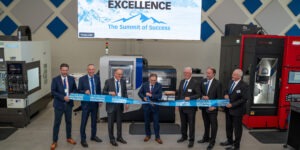REBUILD OR BUY NEW? GRINDING IT OUT
Remanufacture with no prints or buy new at $4 million per machine? That was the question that three different sized 1950s-era cylindrical-type grinders posed for a large crankshaft supplier to the energy, power generation, earth moving, locomotive, mining, marine, stamping and forging industries. The answer?
Posted: May 13, 2011
KRC Machine Tool Services (Independence, KY) is highly respected for its ingenuity and craftsmanship in breathing new life into hopeless machine carcasses (as well as creating entirely new concept machines). For more than 20 years, the company’s innovation, reliability and dependability have set it apart and ahead of the competition for special machine building and machine tool solutions. The company recently completed and shipped three large, half-century old crankshaft grinders to one of North America’s premiere crankshaft manufacturers.
THE GRINDERS
The machines in this project are cylindrical-centered crankshaft grinders, meaning cylindrical-type grinders with indexable/adjustable chucks that allow them to grind the shaft off center to create the throws for the large crankshafts. The crankshafts are forged and heat-treated steel. Applications for this equipment include energy, power generation, earth moving, locomotive, mining, engines for marine, large compressors for oil fields, and multi-ton stamping and forge presses that require a crank or eccentric shaft to provide ram movement. These are very large 7 m to 11 m cranks, and not many companies have the capacity to completely manufacture them.
THE HISTORY
Some years ago, the customer bought an English company. As part of the acquisition came a number of 1950s-era Friedrian Schmalts manual crankshaft grinders. The company put one of the grinders into production and three others in storage. Years later the company needed the machines that had been warehoused, but a problem immediately presented itself. The grinders in storage were not intact. They were in complete disarray. The beds were stacked upon each other, stored outside and exposed to years of weather which caused them to warp. Inside the warehouse, the headstocks, tailstocks, saddles, wiring, attachments and other mechanisms, were scattered about on pallets.
In reviewing its options, the company contacted KRC to determine if it would be in their best interest to remanufacture the machines or scrap out the carcasses and buy new at about $4 million-plus per machine – that is if they could even find a builder who could or would do the job. “We welcomed the project and even suggested some enhancements to automate the manual machines. That made the decision easy,” says systems sales manager Matt Collins of KRC. “The remanufacturing package that we, along with the support of our strategic partners, offered would update the machines from manual to CNC. This would provide the customer a highly flexible, robust control system configured specifically to meet their unique needs. The remanufactured package would also replace all components and systems (electrical and hydraulic). In addition, it would add unique features, such as automatic dressing and automatic part gaging. An optional feature to automate the chucking and indexing process was also offered.”
WORKING WITH THE METAL PUZZLE
“One of the things that immediately struck us about these cylindrical grinders was that the components and assemblies appeared to be suitable for any of the three machines, even though they were different in size. One grinder was small, in the range of 6 m to 8 m, and the other two were larger, in the range of 10 m to 12 m,” noted Collins. “Another hindrance was the fact we didn’t have any prints and, if we would have, they probably wouldn’t have helped much after all these decades.”
However, there was a manual machine in the customer’s plant that Collins and his engineers could refer to and get a feel for where the major components belonged. After a few visits his team had a pretty good understanding of the original machine configuration. As the metal puzzle for the small grinder began to come together, pieces were sent out for reworking. The bed was sent to a firm in Cincinnati for planing and machining, while the carriage was delivered to a company in Troy, OH, for modifications. Other components and assemblies were torn down and remanufactured. Some new replacement components were purchased from local strategic suppliers and then altered in-house to suit their particular function.
“Basically the only components that weren?t new on the machines were the major castings,” added control engineer Terry Smith. “We pieced the puzzle into a modern machine. This particular grinder was one of the more challenging machines that we have ever remanufactured. This was not a machine that was pulled out in one piece. This was in every way a start-from-scratch project.”
COLLABORATIVE LEARNING
“Most of the learning curve on this project was associated directly with the grinding process,” continued Smith. “We’ve had some experience in grinding, but there was just so much to learn about this unique crankshaft grinding process. If we didn’t get the process steps down right, we’d never be able to provide a control that would function in a fashion that would meet the customer’s needs.”
Smith explained the process. “We sat down numerous times with their managers and had them go through and map out all the process pieces so we could put together a robust, flexible control program that embraced all the steps in the correct sequence,” he said. “We did a step-by-step, hand-in-hand, walk-through process where they told us exactly what the machine should be doing next and we’d say “ok, that is what we are going to design the machine to do”, and so forth. Without having them involved, this would have been a very difficult project. The first few times we went through the process control program with them, we were still missing pieces that were unforeseen to us.”
“Now all of the operations are performed by using a Siemens 840D control. All changes are built into the control, whether it is depth of cut, dressing cycles, redressing the wheel, the drawback cycle or changing feeds and speeds. It knows the profile you tell it to use and it reuses that profile. We have graphical screens with data entry fields, so it’s a matter of knowing the terms and being able to pick them out of the graphic illustrations. Basically, when we were finished we had designed and written multiple custom conversational programming screens, specific for the customer’s crankshaft grinding applications.”
OPEN FOR ALL GRINDERS?
“Yes, and no,” answers Collins. “This was more of a unique opportunity. We don’t really want to say that we now work on all types of grinders, because there are a lot of different types of grinders out there. This has been a very special application with us working with the customer, who has the experience, and knows the process of grinding, particularly the grinding of crankshafts. Together, we worked as a team to come up with the machine configuration and then develop customized advancements that include a fully modernized CNC machine, a robust programming package, automated gaging, automated dressing, automated indexing and chucking.”
Collins smiles and remarks, “So to say we now do grinders . . . well, yes, but only in cases where it’s a very unique situation and we can work closely with our customers to develop a machine that didn’t quite exist before.”
KRC Machine Tool Services, Inc., 10065 Toebben Drive, Independence, KY 41051, 859-283-8300, Fax: 859-283-8303, www.krcmts.com.














